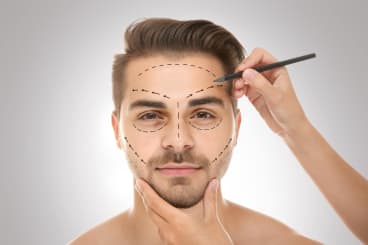 Breast Augmentation with Fat Transfer
Breast Augmentation with Fat TransferWhy Everyone Is Talking About Fat Grafting
The biggest trend in cosmetic surgery is fat grafting, which takes fat from one place to plump another. Here's why.
If you’ve thought to yourself, I wish I could take some of the fat here (gesturing to your thighs) and put it in up here (gesturing to your breasts), well, you can. And while you’re at it, you can even put some of that flab under your eyes and into your cheeks — or whatever area of the body you could use some extra volume. The appeal of getting rid of fat where you don’t want it and adding it to where you do is why fat transfer procedures (also referred to as fat grafting or fat injection) are on the rise. In fact, a survey of plastic surgeons conducted by the American Society of Plastic Surgeons showed that fat transfer to the face was up by 22 percent in 2017.
How Does A Fat Transfer Work?
A fat transfer works with the surgeon performing liposuction on a "donor site" — usually the stomach or thighs — to extract fat through a small incision and using a cannula. “You don’t need to be particularly heavy to have this done,” says Michael Frederick, MD, a board certified plastic surgeon in Palm Beach, FL. “There are very few people I can’t get any fat out of.” Then, the doctor rinses the fat to remove broken fat cells, oils, and other things that might be mucking it up. (There are a few different rinsing techniques; Jason Bloom, MD, a board certified facial plastic surgeon at the Main Line Center for Laser Surgery in Ardmore, PA, uses Puregraft, which resembles an IV bag with filters in it.) The doctor injects the rinsed fat into areas of the body that you’d like to be a little fuller, like your butt, breasts, or face. This may sound intense, but as cosmetic procedures go, it's pretty straightforward and done under local anesthesia. You might experience some soreness and swelling in the area where fat was extracted, but it will only last for a few days.
What Are The Perks Of Fat Grafting?
The first major perk of fat grafting is that you’re getting a two-for-one deal here: reducing body fat in one area and enhancing another, all in one appointment. You can even have your harvested fat injected into more than one part of the body at a time. Patients also like that it’s a natural way to create volume; instead of having a foreign substance inserted into your body (like silicone breast implants or synthetic facial filler, you’re using your own fat. This reduces the chances of rejection or allergic reaction and can produce more natural-looking (and feeling) results. Plus, the results are permanent, as opposed to synthetic fillers that only last a few months. “There is retention of 70 to 75 percent after five years,” says Dr. Bloom.
Fat grafting procedures can also help rejuvenate the skin, although it’s a slightly different type of fat transfer than the method used simply to increase volume. “Nanofat grafting involves harvesting fat and then passing it through a series of screens or meshes to grate down the fat cells to stem cells, which can revitalize the skin,” says Bloom. Research shows remarkable improvements in skin quality and facial rejuvenation six months post-operation. However, this method doesn’t really increase volume, so Dr. Bloom sometimes uses a combination of both types to give a patient fullness while also revitalizing the skin.
What To Keep In Mind About Fat Grafting
Experts say fat transfer procedures are an effective way to add volume to the face and body, but as with all surgical procedures, there are a few side effects to keep in mind. For one, “it’s somewhat unpredictable,” says Dr. Frederick. While fat grafting is great at creating volume, it doesn’t work as well for contouring and fine-tuning. This is why Dr. Bloom uses the fat grafting technique in some areas of the face, like under the eyes, in the cheeks, and along the jawline, but not others, like in the lips, which require precise shaping. The same issue applies to fat transfers to the breasts. “While it can increase the size of your breasts, it doesn’t create shape,” says Frederick, who sometimes uses a combination of implants and fat grafting to create natural-looking breast augmentation. Another potential downside to transferring fat to the breasts is that it can sometimes cause benign cysts referred to as fat necrosis. If the fat is not dispersed properly, “it won’t get the blood supply that it needs, which causes the fat cells to die. And you could wind up with areas of hardened fat,” says Dr. Frederick.
Lastly, fat can get homesick. “Fat acts the same way, no matter where you put it,” says Dr. Frederick. For example, if you tend to gain weight in your stomach, and you have fat removed from your lower abdomen and injected into your butt or your boobs, you’ll now be more prone to weight gain in those areas. But, hey, if big boobs or a big butt is your goal, consider this an added perk.
Related Procedures

AI Plastic Surgeon™
powered by'Try on' aesthetic procedures and instantly visualize possible results with The AI Plastic Surgeon, our patented 3D aesthetic simulator.


